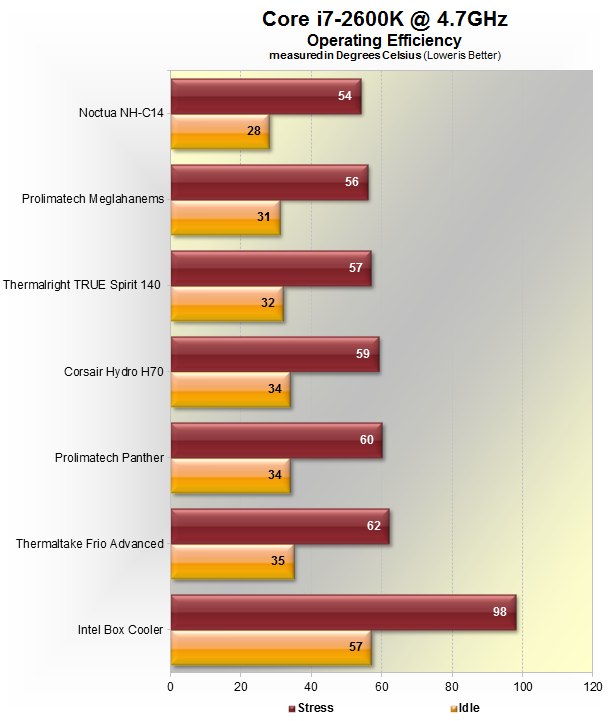Testing Notes, Operating Temperatures
Both the idle and stress tests are run for 20mins and then the lowest/maximum values are recorded. Prime95 is used to place all four cores under 100% load for the 20 minute period. The room's ambient temperature is kept at a constant 21 degrees.
When testing the coolers we remount them onto the CPU three times and record the idle/load data. Each time the thermal paste is wiped clean from both the CPU and the heatsinks base. The best result is displayed rather than the average of all the recorded data.
Because we record the temperatures using EVEREST Ultimate Edition, the same version is used every time with the same motherboard using the exact same BIOS revision. Furthermore, the same Intel Core i7 2600K processor was used clocked at the default 3.4GHz as well as an overclocked 4.7GHz configuration.

All tests were conducted using a vertical motherboard orientation, positioned upright in a traditional tower computer case. The heatsinks that feature heatpipes are positioned so they span horizontally.
Furthermore, all power saving features have been disabled when testing with our Core i7-2600K processor. This means CPU Enhanced Halt (C1E), C3/C6 State Support, CPU Thermal Monitor and EIST have all been disabled. Turbo Boost has also been disabled locking the frequency of the processor.

As you can see, the Intel stock cooler performs poorly even when the Core i7-2600K is operating at the default 3.4GHz. Although the Prime95 small FFTs test places maximum stress on all cores, you can expect similar loads when performing certain tasks such as encoding. Even at idle with the power saving features disabled, the stock cooler idled at 45 degrees.
In comparison the aftermarket coolers did a significantly better job at keeping the Core i7-2600K cool. The Thermaltake Frio Advance which was the worse performing cooler still reduced the load temperature to 47 degrees, just 2 degrees warmer than the Intel stock cooler at idle. The Frio Advance was also able to reduce the idle temperature to 31 degrees.
The Prolimatech Panther was able to shave another 2 degrees off the stress test, and idle temperatures by 4 degrees. Then the Thermalright True Spirit 140 matched the Panther at idle but reduce the stress temperature by another 2 degrees. This means that the True Spirit 140 is able to match the stress temperature of the Prolimatech Megahalems.
Finally, the Noctua NH-C14 took the top spot with a stress temperature of just 41 degrees. The idle temperature was also reduced to 24 degrees, meaning a few degrees above ambient room temperature.

At 4.7GHz with a 1.40v voltage tweak, the Intel stock cooler allowed the Core i7-2600K to reach 98 degrees before crashing. The idle temperature was also very high at 57 degrees, which was the same temperature that the Thermalright True Spirit 140 was able to keep the processor when stressed.
The performance trends found with the Core i7-2600K clocked at 4.7GHz were similar to those at 3.4GHz. The Thermaltake Frio Advanced was 2 degrees warmer than the Prolimatech Panther, which was 3 degrees warmer than the Thermalright True Spirit 140. Finally, the Noctua NH-C14 ran the coolest rig at just 54 degrees when fully stressed.
Even when overclocked all the coolers were near silent with the Core i7-2600K at idle. When stressed the Prolimatech Panther remained silent and the True Spirit 140 was barely audible. The Thermaltake Frio Advanced was audible but not what we would call loud, while the Noctua NH-C14 was unquestionably loud under load.
